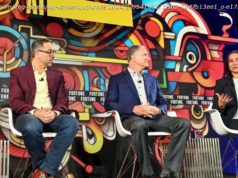Whole Foods co-founder and CEO John Mackey started a natural foods market in an old house in Austin using $45,000 raised from friends and family.
Amazon paying $13.7 billion for Whole Foods Market may be a savvy business decision for both parties — Amazon has been dabbling in groceries and Whole Foods needs to better compete with the burgeoning natural foods market it helped launch. But the founding ethos of the companies are as different as a chocolate pop tart and organic oatmeal.
Amazon is the result of Jeff Bezos ‘ obsession with the efficiency and scalability of the Internet. The Seattle-based tech giant’s vision is “to build a place where people can come to find and discover anything they might want to buy online” according to its mission statement, and to get it to you overnight. The company has grown to have a market capitalization of almost $475 billion because Americans will pay for convenience.
Whole Foods, meanwhile, is the result of an idealistic attempt to change the way people eat, making them healthier, while promoting sustainable, fairly harvested foods and ethically sourced meats.
After hitting a peak stock price of over $60 in 2013, Whole Foods started to get beaten by the very same competition that it inspired into existence. A leader in bringing natural foods into the mainstream, soon food retail giants like Wal-Mart and Kroger started selling in the category, Trader Joe’s launched, meal-at-home kits like Blue Apron changed the way healthy eaters started shopping. With all the competition, Whole Foods suffered.
Its stock price fell by more than half and activist investors like Jana Partners began to assert ownership rights, much to the dismay of co-founder and co-CEO John Mackey, the only original founder still with the company. Though he admitted the company had changes to make, Mackey was against selling Whole Foods.
Mackey, whose salary as CEO has only been $1 a year since 2006, will make $8 million from the sale of Whole Foods to Amazon, surprisingly little for a company sale of this size. He owns 980,000 shares of Whole Foods stock and the sale is based on a share price of $42. Jana Partners’ profit will reportedly be $300 million.
It all started on a vegetarian co-op in Austin
Mackey, now 63, grew up eating cocoa puffs for breakfast, a hamburger for lunch and boxed macaroni and cheese for dinner, he tells host Guy Raz on a recent episode of the NPR show, “How I Built This.” He didn’t start to understand that there was a value in eating a vegetable-based, healthy diet until he moved into a vegetarian co-op, when he was 23, which, at the time, he thought of as an adventure.
At the vegetarian co-op, Mackey, who had dropped out of college because he found the required classes boring, became the buyer for the group. He was fascinated with the potential of healthy eating.
Without a diploma but newly inspired by the power of organic eating, Mackey and his then girlfriend, Renee Lawson Hardy, decided to go out on their own and open a natural grocery store. They set out to raise $50,000, but could only muster $45,000. in 1978, they opened shop on the first floor of an old house in Austin with a cafe on the second floor. The coupled lived on the third floor. It was called SaferWay, it didn’t sell meat or anything with sugar and it primarily served Austin hippies.
Craig Weller, Renee Lawson Hardy, John Mackey (L to R) .
Two years later, Mackey and Hardy approached another local natural grocery store, Clarksville Natural Grocery, owned by Craig Weller and Mark Skiles, about joining forces. The four went into business together to open the first Whole Foods Market in 1980. In an effort to expand the clientele, the four started selling meat, beer and wine.
From the first day they opened, Whole Foods Market was a success. “People were so excited about this first store. It was amazing, and we didn’t do any advertising. We just opened the doors, ” says Mackey on “How I Built This.” “The word of mouth was incredible. The whole Austin counter culture hippie community knew about it immediately.”
Near-death experience
When Mackey looked to rent the space that would become the first Whole Foods Market, the landlord mentioned it was in a 100-year-flood zone, meaning that once every hundred years the area would flood. Mackey, enthusiastic, young and eager to grow, didn’t flinch. He was willing to take the risk. It turned out to be a losing bet.
In the Spring of 1981, that 100-year flood landed. The store was drowned, sewage forced out of pipes, inventory ruined and looters came and trashed the store. Mackey remembers wading through the dark waters to get whatever cash they had left in the store safe.
They didn’t have flood insurance. “We thought we were pretty much out of business, ” says Mackey. “By all rights, Whole Foods should have died through that flood. We had to rebuild the store and it was going to cost a lot of money to do that and we just didn’t have the money, so I thought, we all thought, we were finished.”
The Austin community stepped up to save the business. Customers pitched in to help with the cleanup effort, investors put in more money, banks extended credit lines and team members (employees) worked for free to get the store back open.
“We were really united around that near death experience, ” Mackey says. When they got the store re-opened, Mackey was determined to expand. “I wanted to open a second store after the flood. It was like, we can’t put all of our eggs in a basket that might float down the river.”
In 1988, when Mackey approached venture capitalists for the money to expand in a significant way, he was repeatedly rejected. He remembers one VC telling him the market was too niche: “You know, John, I see you have got a pretty good business her, but it looks to me — I looked at all the stores — like you are a just a bunch of hippies and you are just selling food to other hippies and I don’t think that is a very big market, ” he told Mackey. A decade later, that same venture capitalist told Mackey not investing in Whole Foods was the worst decision he’d ever made.
Mackey did raise venture money though: Whole Foods sold 34 percent of the business for an $8.5 million valuation, which at the time was about 15 to 20 percent of sales, says Mackey on “How I Built This.” Hungry for cash to grow further but uninterested in handing over more of his company to venture capitalists, Mackey took Whole Foods public in 1992 and raised $28 million valuing the company at $100 million. With the cash, Whole Foods scooped up a slew of other natural food markets around the country.
Whole Foods’ growth continued as eating healthy became increasingly mainstream. In 2016, there were more than 460 stores in the United States, the company did $16 billion in sales and had 87,000 employees, according to a recent financial disclosure.
Of course, that growth didn’t come without controversy.






